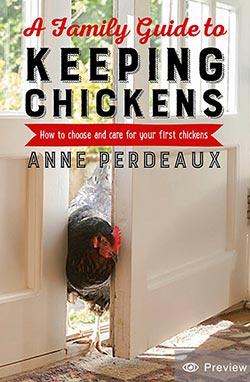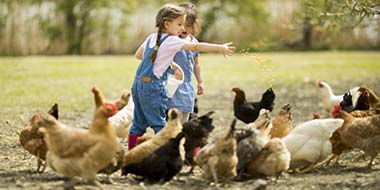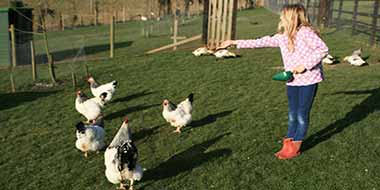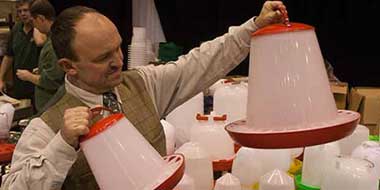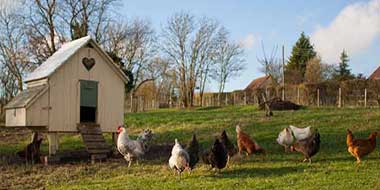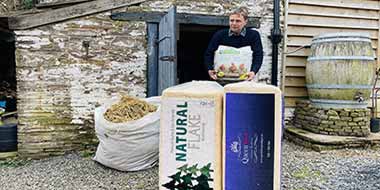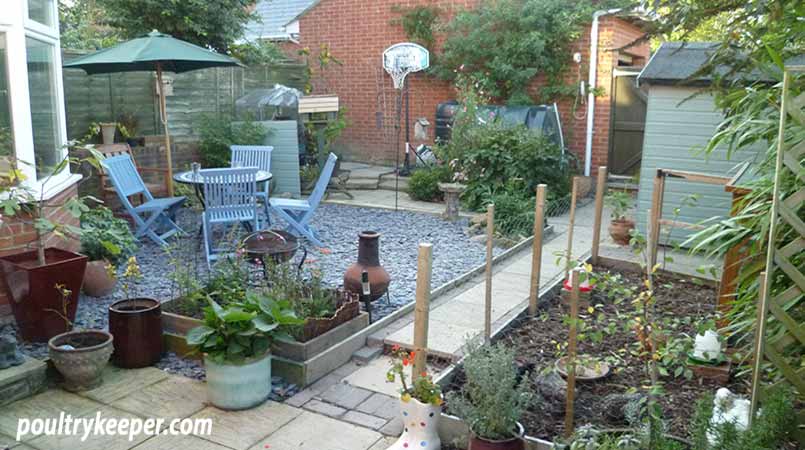
How long is a piece of string? Although chickens will appreciate all the room you can give them, it’s still possible to keep contented hens in even a small garden.
Managing chickens successfully in a limited area will require some extra forward planning. It will also be more labour intensive than keeping free-range chickens, as the run must be well-maintained to avoid unpleasant odours and the build-up of diseases. With care though, a chicken run can actually become an attractive garden feature – and you’ll get eggs into the bargain!
First things first
Check for restrictions
Before going any further, there’s a good chance if you’re asking the question of how much space chickens need then you’re living in a semi-built-up area? Do check that there are no restrictions on keeping hens at your property.
Chickens are usually considered as ‘livestock’ by local authorities, and even country areas may have rules about keeping animals in back gardens. There is more information here on UK and US Laws/regulations for chicken keepers.
In the US, it varies considerably by state, county and even town. Check your local zoning regulations, laws and bylaws. Even searching for “keeping chickens + your town or state” will often reveal news articles of laws that have been passed (or challenged by people wanting to keep some hens).
So, you’re allowed to keep chickens? Let’s get back to the question:
How much space do chickens need?
Measure up the available space
A square metre per hen is the basic minimum in a back garden run, although two square metres for each hen would be much better.
The golden rule is not to overstock. Hens need company, and three is an ideal number – giving you a ‘spare’ hen should one suddenly decide to turn up her claws. If you can allow slightly more space than the minimum, don’t be tempted to squeeze in extra birds. Give your three hens as much room as possible.
A high-rise henhouse is a good space-saver as the area underneath can form a sheltered part of the run. Keeping chicken houses off the floor also helps to get rid of rats that can sometimes move in if there is feed, shelter, and water.
Positioning the run
If the garden is tiny, there may not be much choice of location, but try to find a well-drained area with some protection from the prevailing weather.
Chickens overheat easily, so their run (and especially the henhouse) shouldn’t be exposed to the full heat of the summer sun. However, they enjoy a spot of sunbathing, which is good for them as long as they can retreat to a cooler place when they’ve had enough.
When you consider how much space chickens need, remember that placing the run against a garden wall or fence will give the chickens a feeling of security and provide some shelter too. Climbing plants grown up the fence look attractive and give extra shade – make sure any plants within beak reach are non-toxic to chickens and are well-established before the chickens move in.
Preparing the site
New chicken-keepers sometimes build their chicken run on a small patch of grass, only to watch with horror as the whole thing turns to dust. Chickens love to eat grass, but they eat with their feet – everything is scratched up as they search out the roots and insects underneath.
Once this has happened there will be mud in the winter, dust in the summer, and the soil will become riddled with parasite eggs that cause worms. This happens even in large runs, depending on the number of chickens – although a few chickens in a large run take longer to achieve it and give the ground a chance to recover.
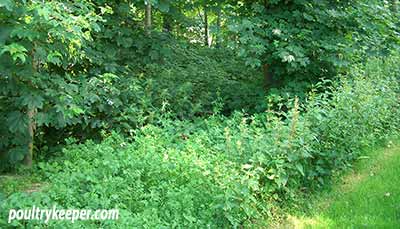
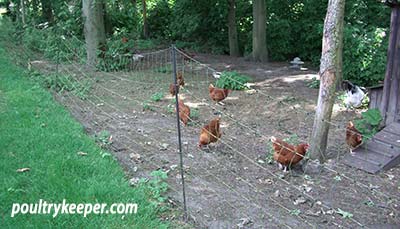
There are three ways around this problem. You can protect the ground with a thick layer of scratching material such as hardwood chips, which can be regularly cleaned and occasionally replaced. This will allow the chickens to benefit from any bugs they can dig up from the soil beneath, but in wet weather the run is likely to need extra attention.
Alternatively a run can be placed on paving slabs or concrete with a good covering of suitable material. A solid surface is easier to keep clean, and prevents predators or rodents from tunnelling in, but both systems have been used successfully.
Finally, you can fence a large enough area and keep the number of chickens down so the ground can recover.
It’s important to make your preparations before the chickens arrive. Once the chickens have turned a run to mud, anything added will just be absorbed into the mass. There will then be no alternative but to dig the whole thing out until you are back down to solid earth.
Scratching material for chicken runs
If the run is open to the elements, hardwood chips are a good choice, and they can be composted. Longer lasting options include sand, gravel or rubber chippings (specifically for chicken runs). Rubber chips can be hosed down, but they are laid over a membrane, and good drainage is required to make sure that waste matter can be properly washed away.
You could also use straw (which can occasionally cause digestive problems if the chickens eat it), wood shavings (which may blow around the garden), or shredded hemp.
Hay or bark shouldn’t be used for chickens as they contain harmful spores – and hay quickly turns into a matted mess. Bedding for the chicken house isn’t covered in this article, but if you’re wondering what you should use, then you can find out more here: What is the Best Bedding Material for Chickens and Ducks?
Selecting your hens
Not all chicken breeds will live happily in a confined space, so choose carefully. Many of the light ‘layer’ types, especially those of Mediterranean origin, tend to be flighty anyway and will become fretful if restricted. Some of the heavy breeds are less active but can easily become fat in a small run.
You may decide on bantams if space is tight, and there are small versions of most of the large breeds – bear in mind that they will share many of the characteristics of their larger relatives. Bantam varieties of full-size breeds often lay as well if not better than their big cousins. Their eggs will be smaller, although not necessarily proportionately so.
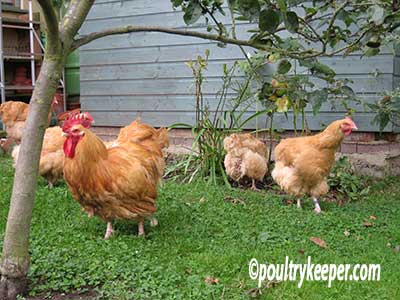
There are also the ‘true bantams’ with no large equivalent, and many of these make lovely pets. They aren’t the best of layers, and their eggs will be small, but bantam eggs are often rich in colour and flavour.
Hybrid chickens have been bred for docility, and most types will live comfortably in a run – or you could adopt some ex-battery hens, who will find even a small run relatively spacious.
Some chickens are better off kept in a covered run. Silkie chickens, for example, as their strange fur-like feathers are not very weather-proof. Chickens with heavily feathered feet and legs (such as Pekin bantams) become bedraggled and miserable in muddy conditions. Very tiny bantams are vulnerable to several predators and will be safer in a roofed run.
Caring for chickens in a small run
Chickens in a confined space will be more challenged by internal worms, which are often passed on via droppings, so it’s important to establish a good worming regime and keep everything as clean as possible.
Clean surroundings also help keep down smells and diseases. Try to pick up the worst of the droppings from the run daily (keep a bucket and rubber gloves handy), as well as raking over and sanitising the run material.
Every so often (the frequency will depend on what scratching material you are using), the run should be cleared out completely and the base dealt with appropriately. A solid base can be hosed down with disinfectant, while soil should be treated with a ground sanitiser designed to destroy worm eggs and larvae.
The house also needs regular cleaning. Usually, once a week is enough for a thorough going over – although you may find it necessary to do a quick clean more frequently, especially in summer. Skipping out droppings daily will help, and a removable droppings board under the perches makes this task easier. Disinfectants and sanitising powders will help to keep everything clean and fragrant.
Don’t forget that chicken litter makes excellent compost – offer any that you can’t use to keen gardeners, or try your local allotments. Maybe you can exchange it for some surplus vegetables that can be fed to the chickens!
Entertaining your chickens
Chickens can become bored in a run, and if not kept busy may start indulging in anti-social behaviour such as feather-pecking. Luckily it’s not difficult to amuse a chicken.
Make sure you provide a dust-bath, so your hens can occupy themselves with bathing and preening. This is vital to their health and happiness, but is often overlooked. A dust-bath can easily be made from a plastic box and some dry soil or play sand (not sharp sand).
Chickens enjoy green foods, and as there won’t be any grass in their run you should supply some leafy vegetables.
Hang these up so they don’t get trampled. It also gives the chickens some exercise if they have to stretch or even jump a little to get to the goodies.

Dry mash is more difficult for chickens to pick up than pellets and thus keeps them busy eating longer. However, it can be messy, and spillages must be cleared away, or they will start to smell. It’s not suitable for chickens with beards as it sticks to the feathers. This page provides information on feeding chickens if you would like to learn more.
Chickens like to perch in the daytime as well as at night, so give them some logs or branches to play on.
It can be done!
This patio garden is just 10 by 8.5 metres, but the chicken run adds an intriguing extra dimension.
The chickens have a raised house with a covered run attached. Surrounding this with wire netting has given the chickens more space while keeping them off the garden – this fence isn’t intended to give protection from predators, but the high walls around the garden provide security.

The run is covered with hardwood chips, which are replaced every three months – more often in very wet weather. Cleaning is taken seriously to eliminate smells, but the whole family helps to keep the chickens in the manner to which they have become accustomed
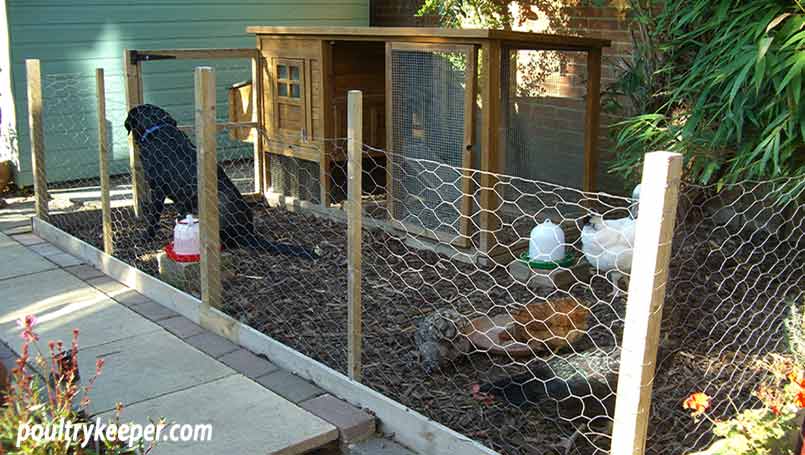
The hens have become much-loved pets – and their eggs as a real bonus with two growing boys to feed. Even the family dog has taken to his feathery companions, and likes to visit occasionally to see if there is any leftover food!
How much space do chickens need? Well, as you can see here, as much as you can spare within reason!
A Family
Guide to
Keeping Chickens
Anne’s book is a full colour, practical book which is ideal for beginners.
Even someone who has never kept animals before should be able to follow the clear, detailed guidance that is given.
It includes planning for your first chickens, understanding their behaviour, choosing suitable housing as well as chickens, equipment you will need, and routine care. Protecting against predators, dealing with parasites and ailments, broody hens and much more.
